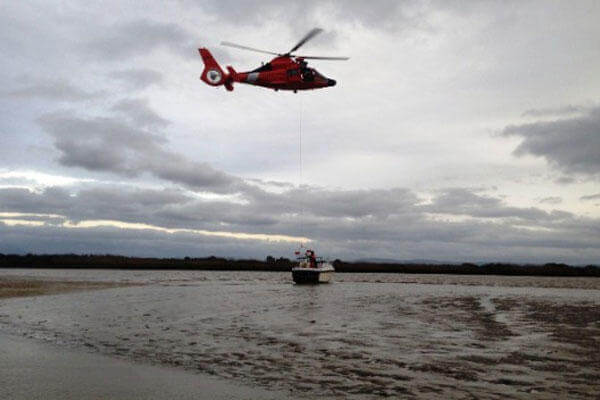It began with a 911 call from someone stranded aboard a 17-foot recreation boat that was soft aground in the low tide waters near the San Mateo Bridge. A rescue boatcrew from Station San Francisco was deployed to assist, but the stranded vessel was too far into the shallow water and the tide was going out.
The decision was made to lower Petty Officer 3rd Class Ernie Child, an aviation survival technician, from one of Air Station San Francisco’s MH-65D Dolphin rescue helicopters to the ground near the vessel.
“We had to do a very high hoist to ensure there was no rotor wash to impact the survivors – it would have been pure mud and we wanted to minimize impacts to the family,” said Child.
Child waded through the low tide mud with warm blankets and a radio to meet with an anxious father, two daughters, a son and a dog. The family spoke primarily Spanish but the father was able to communicate that they were cold and tired, having been out for two hours already. The little girl was crying. The father had just recently bought the boat, and it was his first time driving it. The boat had life jackets and an anchor. The father also said the boat was “smoking and may not start again” – he had disconnected the batteries as a precaution.
“He wanted to get close to shore and ran aground,” said Child. “I looked at the kids and told him I wanted to get the whole family out, and we’d get the boat later.” Child updated the situation with the helicopter pilot via VHF radio and then calmly demonstrated to the family how to get into the rescue basket.
“They seemed very scared but I reassured them that everything would be okay. The little girl was still crying, but they were all happy to learn that they were getting out.” As it turns out, none of the family members had ever been in a helicopter before.
The oldest daughter went with the dog first and then the youngest daughter, who smiled when she got into the basket. The son went into the basket next, and by then the helicopter was at full capacity.
Child stayed behind with the father until the crew returned 15 minutes later and hoisted him. Child then made sure the vessel’s battery was disconnected, all loose gear was secured and that the boat was anchored. Then the helicopter flight mechanic sent down a bare rescue hook and hoisted Child aboard.
Child says the most challenging part of the rescue was communicating with the family but that he was able to overcome that challenge by pointing and making hand gestures to communicate messages.
“This was my most gratifying case so far because it was the first time I saved children or a pet,” said Child. “They were freaked out, and had never been on a boat before. It feels good to get people out of bad situations.”




























